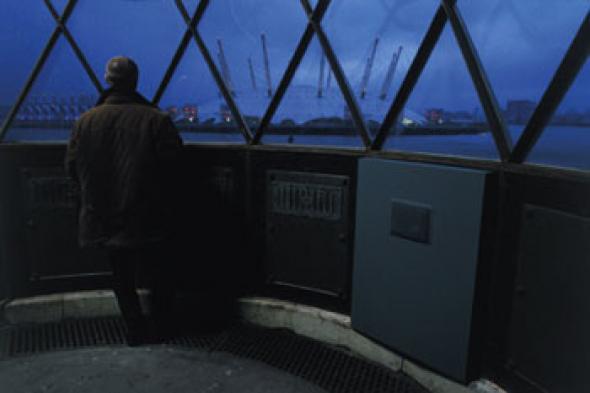Marking Time
Jem Finer’s Longplayer is designed to perform for a thousand years without repeating itself. Hari Kunzru went down to London’s docks on new year’s eve to see it kick off.
If the Millennium meant anything at all, it was not about a digit change in a particular calendrical system, but the opportunity to contemplate the span of a thousand years. As the celebrations focused down on the fleeting instant of transition from 1999 to 2000, distracted by amplified countdowns and blinded by laser lightshows, we missed the big picture. The Millennium (like the total eclipse which passed over Europe and Asia in Summer 1999) gave us a rare opportunity to meditate on duration, on the existence of time independently of human scales and measurements. A millennium is a scale somewhere between the human and the geological, a uniquely cultural measure of time, in which we think (when we think of millennia at all) of ‘the rise and fall of civilisations’, of ‘progress’, and other nebulous, hopeful concepts relating to our feelings about past human mistakes and future possibilities.
One of the few millennial projects which gives any handle on the span of a thousand years is Jem Finer’s Longplayer. Finer, a sound artist and former member of The Pogues, has created a piece of music whose performance will last a thousand years. Instantiated, for the moment, on computer equipment installed in three locations (two in London, one in Sydney), it was switched on at lunchtime on December 31st 1999. Taking as its basis a twenty-minute composition of long held tones, made by Tibetan singing bowls (both struck and gently resonated by running wood around their rims), Long Player performs an iterative series of mathematical operations on this initial material, layering sequences together which change at different rates, so that throughout the millennial duration of the work, it will not repeat itself. The bowls themselves function like oscillators, their slightly irregular overtones combining together into variable and unpredictable harmonics.
To the small group who gathered for the grand switch-on at the Trinity Buoy Wharf Lighthouse in London’s East India Docks, the power of the work was unmistakeable. As the eerie music droned out across the water from the old lighthouse, we watched black helicopters buzzing round the Millennium Dome, airlifting in materials for that night’s orgy of Britannic self-congratulation. Post-industrial Docklands has become the imaginative playground of successive UK administrations, and the lighthouse forms one corner of a triangle with the Dome and Canary Wharf tower. It is hard not to join with Iain Sinclair in seeing an occult quality to the projects which have remade this landscape; the phallic, almost priapic 1980’s sex magic of the tower succeeded (and opposed) by the mons veneris of its Blairite successor. On the stroke of midnight, as green lasers struck the ‘jewel’ in the centre of the Dome, (in the climax of whatever secret ritual this structure had really been built for), Longplayer was filtering its keening, mourning music into the subconscious minds of the New Labour adepts — the second of its current physical sites being inside the Dome itself.
Finer and his backers, who include Brian Eno and members of the Danny Hillis’s Long Now foundation, know that to succeed, Longplayer has to incorporate strategies to perpetuate itself. A trust has been set up, as the first stage in creating an institutional structure which will persist for a thousand years, and the piece itself has been designed in such a way that it could, at some future date, be instantiated on mechanical equipment, or whatever other means are found once the current generation of PC’s have broken down, become museum pieces, or fallen away into dust.
Hari Kunzru <hari AT metamute.com>
Information +44 (0)20 7336 6803http://www.longplayer.orgphysically at Trinity Buoy Lighthouse, London, The Millennium Dome, London, MoCA Sydney<contact@longplayer.org>
Mute Books Orders
For Mute Books distribution contact Anagram Books
contact@anagrambooks.com
For online purchases visit anagrambooks.com








